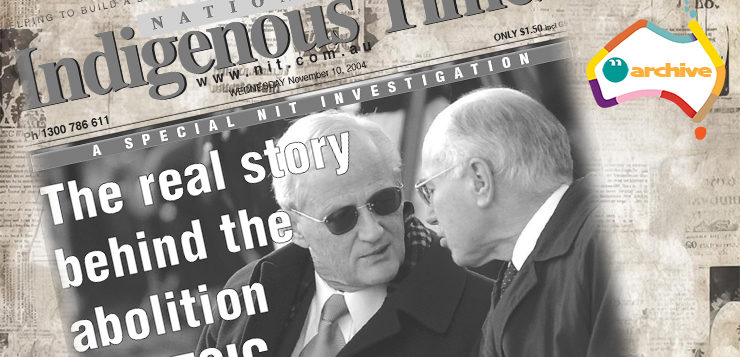 In November 2004, the National Indigenous Times newspaper revealed the real story behind the abolition of the democratically-elected Aboriginal and Torres Strait Islander Commission (ATSIC)… and it wasn’t the reasons publicly claimed by the Howard government. The story came from the leak of a large cache of federal ‘cabinet-in-confidence’ documents to NIT editor Chris Graham and journalist Brian Johnstone, which lead to the now infamous Australian Federal Police raid on Graham’s home and office, surveillance of NIT staff, and the tapping of its phones. An updated version of the story is being published by New Matilda in the lead-up to the Voice referendum on October 14 to help readers form a better historical understanding of the frustrations Indigenous people suffer over the failure by successive Australian governments to deliver basic services to some of the nation’s most vulnerable citizens.
In November 2004, the National Indigenous Times newspaper revealed the real story behind the abolition of the democratically-elected Aboriginal and Torres Strait Islander Commission (ATSIC)… and it wasn’t the reasons publicly claimed by the Howard government. The story came from the leak of a large cache of federal ‘cabinet-in-confidence’ documents to NIT editor Chris Graham and journalist Brian Johnstone, which lead to the now infamous Australian Federal Police raid on Graham’s home and office, surveillance of NIT staff, and the tapping of its phones. An updated version of the story is being published by New Matilda in the lead-up to the Voice referendum on October 14 to help readers form a better historical understanding of the frustrations Indigenous people suffer over the failure by successive Australian governments to deliver basic services to some of the nation’s most vulnerable citizens.
NOVEMBER 10, 2004: Five days after ATSIC formally lodged a High Court challenge to the federal government’s removal of its powers to make funding decisions, Prime Minister John Howard was warned the abolition of ATSIC had now become “a matter of urgency”. The revelations are contained in a leaked cabinet-in-confidence document, dated April 7, 2004, which was written to brief the government on the proposed abolition of ATSIC, a copy of which has been obtained by NIT.
The federal government has always maintained the creation of ATSIS on July 1, 2003, which removed the power of the ATSIC Board to decide who receives its money, was legal and that ATSIC’s legal challenge was a “frivolous waste of taxpayers’ money”. But the leaked document reveals a less confident federal government which was caught out by a series of strategic errors made by the Prime Minister and the former Minister for Indigenous Affairs, Philip Ruddock.
It reads: “Action in relation to ATSIS is urgent in light of ATSIC’s decision to challenge the establishment of ATSIS.
“It is therefore proposed that the government’s decisions be announced immediately and that legislation be drafted as a matter of urgency with a view to passage before July 1, 2004.
If the legislation is not passed by July 1, action could be taken to abolish ATSIS administratively and to move staff functions and programmes to relevant agencies…” But a second, far more explosive cabinet-in-confidence document obtained by NIT reveals the government’s fears were well-founded.
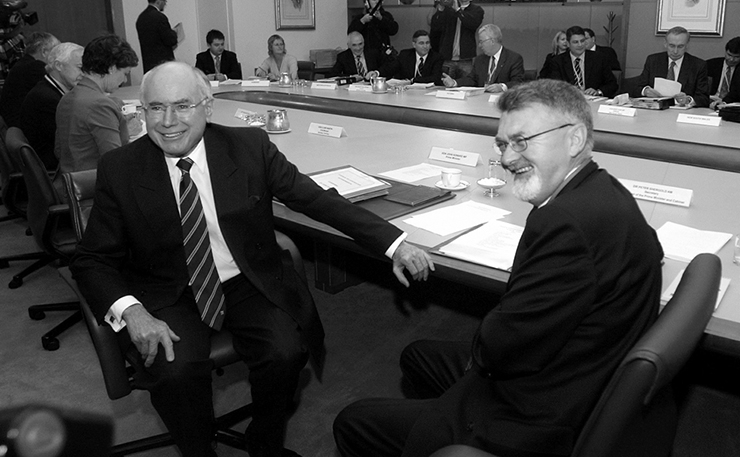
In April 2003, the Prime Minister was strongly warned against the creation of ATSIS by his most senior bureaucrat, cabinet secretary Peter Shergold (see full story page 8).
Mr Shergold was responding to a letter Mr Ruddock wrote to the Prime Minister on April 10, 2003 in which he urged the government to remove ATSIC’s powers to control its own funds – the first time the plan to gut ATSIC had been floated (the letter, ironically, was written three days after Mr Ruddock informed the Prime Minister that every government minister “almost without exception” had failed to properly undertake a major review of government programs to see if they could be better tailored to Indigenous needs – see previous edition of NIT).
Mr Shergold’s advice was also based on a legal opinion provided by the Australian Government Solicitor’s office (AGS), a copy of which has also been obtained by NIT.
Robert Orr QC, the government’s most senior legal adviser, agreed there was a “reasonable argument” that agencies other than ATSIC could spend ATSIC’s money, but he warned ATSIS was not the best way to achieve it.
Stripping ATSIC’s powers through the creation of ATSIS “would be unusual, and involve some risk” he wrote, adding that the move could be subject to a High Court challenge and if that were to occur, the government’s entire $1 billion Indigenous Affairs budget could be frozen while the court ruled on the matter.
In layman’s terms, that means no Aboriginal communities or organisations previously funded by ATSIC would receive any money until the issue was resolved.
The leaked April 7, 2004 cabinet document also reveals:
- The federal cabinet was mislead about the nature of support for the National Indigenous Council. It claimed that influential Cape York leader, Noel Pearson was in favour of ATSIC being replaced with a government appointed body. Mr Pearson has publicly advocated for an elected chairman;
- The National Indigenous Council was intended as a replacement to ATSIC, despite recent claims by Indigenous Affairs Minister Amanda Vanstone to the contrary.
Other leaked federal government documents reveal:
- ATSIC commissioners were threatened with legal sanctions and financial ruin if they did not take immediate steps to abandon the legal challenge;
- The government was provided with information from within ATSIC which was designed to damage ATSIC’s legal challenge;
At the time of press, the Prime Minister’s office had not responded to NIT’s requests for comment.
A Timeline Of Events
What the leaked cabinet -in-confidence documents reveal about the abolition of ATSIC.
April 9, 2003: Robert Orr QC, Deputy General Counsel of the Australian Government Solicitor’s Office responds to a request for advice from Indigenous Affairs Minister Philip Ruddock’s office about the prospects of stripping powers from ATSIC. Orr warns that accomplishing that goal through the creation of Aboriginal and Torres Strait Islander Services (ATSIS) would be “unusual, and involve some risk”. He warns that it could be subject to a court challenge and if that were to occur, the entire Indigenous Affairs budget for the next year could be frozen until the matter was resolved. Orr also warns that the move could not be accomplished without the agreement of ATSIC.
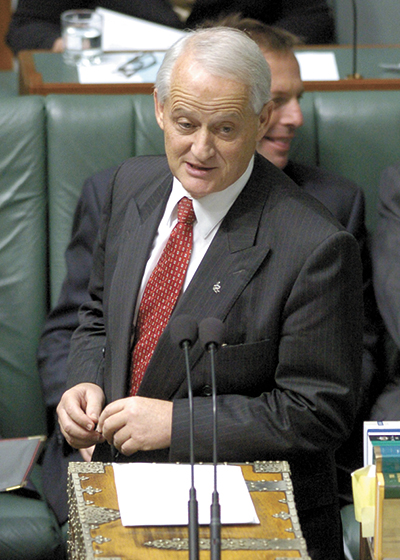
April 10, 2003: Ruddock writes to the Prime Minister outlining a plan to gut ATSIC through the creation of ATSIS. Its purpose is to remove the ability of ATSIC to make decisions on how it can spend money. Ruddock tells the PM the matter is urgent because the activities of ATSIC Chairman Geoff Clark and Deputy Chairman ‘Sugar’ Ray Robinson are causing the government damage.
April 2003: The nation’s most senior bureaucrat, Dr Peter Shergold , writes to the Prime Minister warning him against the creation of ATSIS, as outlined by Ruddock. Shergold warns the PM that a legal challenge from ATSIC was likely and that it would create a “lengthy period of uncertainty”. He also warns of a “highly unsatisfactory split” in accountability within Aboriginal Affairs and counsels the PM to instead bring forward the ATSIC Review. Shergold notes Ruddock already has the power to curtail the activities of Clark and Robinson.
April 15, 2003: Federal cabinet meets and approves Ruddock’s course of action. It also notes the possibility that ATSIC programs might be transferred to mainstream agencies anyway.
April 17, 2003: Ruddock publicly announces that the government will create ATSIS. He describes the changes as “very little” for ATSIC’s elected arm and promises that ATSIS will spend ATSIC’s money according to the policies set down by the ATSIC Board. This later proves to be false.
April-June, 2003: The government sets out to get ATSIC’s signature on the ‘Transitional Agreement’, the contract which would give ATSIS permission to spend ATSIC’s money (bear in mind, the government’s legal advice warns ATSIC must agree to the changes – it cannot be forced on ATSIC). In May the government moves ATSIC’s money for the 2003-04 budget to ATSIS, even though ATSIC still hasn’t agreed to the transfer.
June 6, 2003: A legal opinion from the nation’s leading constitutional lawyer, David Jackson QC advises ATSIC that the government’s proposed creation of ATSIS would be illegal.
June 16, 2003: The ATSIC Board meets to discuss the creation of ATSIS. A minority of commissioners fail to convince the Board to resist the move. The Board votes to give ‘in principle’ support, but adds a safety clause – ATSIC’s support will only be given subject to changes the Board proposes to make to the contract.
June 17, 2003: Key ATSIC Board members meet in Sydney and make a series of amendments to the contract, as per the Board decision. Those amendments are never incorporated into the contract, rendering the Board’s ‘in principle’ support invalid.
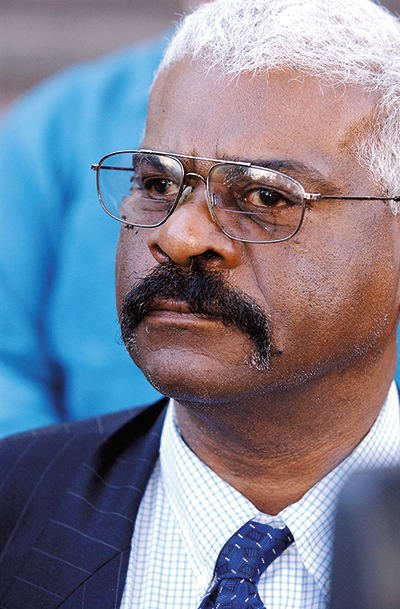
June 26, 2003: ATSIC Deputy ‘Sugar’ Ray Robinson resigns from his position, telling NIT he would rather quit than sign the agreement.
June 29, 2003: With just two days before the 2003-04 budget is due to come into effect, ATSIC still has not signed the contract. Chairman Geoff Clark is told that unless he signs, no Aboriginal organisations will receive any funding in the new financial year (because the government had already moved all of the money to ATSIS and it couldn’t legally be spent without ATSIC’s agreement). Mr Clark is warned that ATSIC will be blamed if funding to communities is frozen. Clark and Acting Deputy Terry Whitby sign the agreement, even though the Board’s support was lost because ATSIC’s amendments were not included.
July 1, 2003: ATSIS is born.
August 17, 2003: The ATSIC Board elects Cairns-based commissioner Lionel Quartermaine as its new leader after Clark is suspended over convictions related to an incident at a Warrnambool Hotel in May 2002 (one of which was subsequently overturned on appeal).
September 17, 2003: A majority of the ATSIC Board begins to “smell a rat” and calls for the abolition of ATSIS and a return to previous arrangements.
October 7, 2003: Amanda Vanstone is appointed to replace Ruddock, who is promoted to Attorney General.
November 28, 2003: The final ATSIC Review report is delivered. It recommends reform, not abolition.
March 3, 2004: NIT reveals details of the Australian Government Solicitor’s advice to Ruddock, warning of the risks associated with the creation of ATSIS.
March 10, 2004: The ATSIC Board votes to mount a High Court challenge against the creation of ATSIS. Vanstone describes it as a “frivolous” waste of taxpayers’ money.
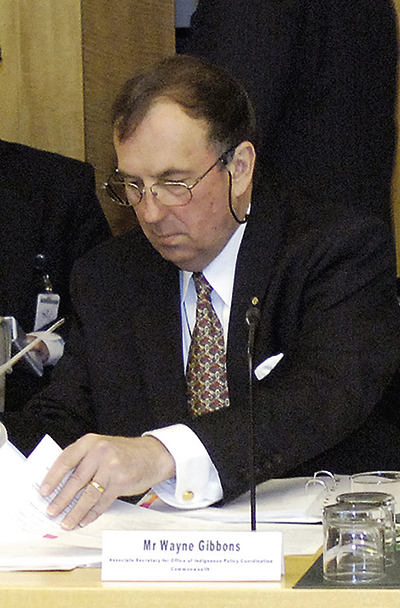
March 12, 2004: ATSIS CEO, Wayne Gibbons, writes to all ATSIS staff directing them not to assist the ATSIC Board in its High Court challenge. The move, ironically, illustrates exactly why the Board decided to challenge ATSIS’ existence – its bureaucratic arm was not obeying its instructions.
April 2, 2004: ATSIC formally lodges its application to be heard by the High Court.
April 7, 2004: A joint cabinet submission from the Department of Prime Minister & Cabinet, The Department of Immigration and Multicultural and Indigenous Affairs and ATSIS warns: “Action in relation to ATSIS is urgent in light of ATSIC’s decision to challenge the establishment of ATSIS. It is therefore proposed that the government’s decisions (in relation to abolishing ATSIC) be drafted as a matter of urgency with a view to passage before 1 July 2004”. It proposes that the National Indigenous Council be formed. The document also misleads cabinet about the nature of support for the proposed NIC – it claims a government appointed board is supported by influential Aboriginal leader, Noel Pearson, when in fact Pearson is strongly opposed to it.
April 14, 2004: Without the knowledge of the ATSIC Board, Acting ATSIC Chairman Lionel Quartermaine and new ATSIC CEO, Mick Gooda meet with a solicitor from a small Canberra law firm to discuss possible flaws in the High Court challenge. Despite the government being the ‘defendant’ in the matter, Quartermaine invites a senior adviser from Vanstone’s office to attend. In a bizarre turn of events, the law firm provides legal advice to Quartermaine which claims three ATSIC commissioners (who were managing the legal challenge) could be criminally charged and face financial ruin. Quartermaine sends the advice to the three commissioners. He also cancels the travel entitlements of ATSIC commissioners which prevents the Board from meeting to discuss ongoing matters relating to the court challenge.
April 15, 2004: Vanstone announces the government intends to abolish ATSIC. The only way this can be achieved is through new legislation, which must pass through a hostile Senate.
May 11, 2004: The government announces its 2004-05 budget and strips ATSIC of most of its funding including the financial capacity and resources to mount the High Court challenge.
May 18, 2004: The federal government submits its defence to the High Court. It relies heavily on the invalid contract signed by Clark and Whitby.
May 27, 2004: The federal government introduces legislation into parliament to abolish ATSIC.
June 1, 2004: The ALP and minor parties refuse to allow the ATSIC abolition legislation through the Senate, instead sending it to an Inquiry, thus leaving the door open for ATSIC to proceed with its court challenge.
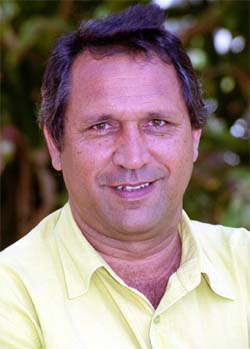
June 24, 2004: ATSIC receives legal advice that individuals could be in contempt of the High Court over the threats issued to the three ATSIC commissioners in April.
July 1, 2004: Most of ATSIC’s programs are moved to mainstream departments and its budget for the 2004-05 year is cut to $3.3 million. All commissioners’ personal staff are sacked or redeployed, leaving no resources or finances to progress the court challenge.
October 9, 2004: The Howard government wins a fourth term in office.
October 12, 2004: Vanstone says ATSIC is likely to be abolished by Christmas.
November 6, 2004: Vanstone announces the make-up of the National Indigenous Council.
Donate To New Matilda
New Matilda is a small, independent media outlet. We survive through reader contributions, and never losing a lawsuit. If you got something from this article, giving something back helps us to continue speaking truth to power. Every little bit counts.

